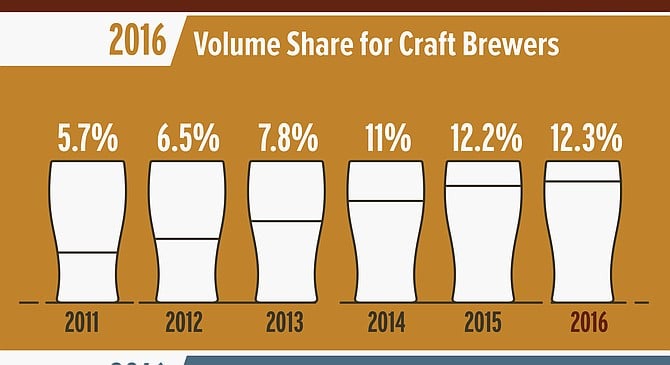 Facebook
Facebook
 X
X
 Instagram
Instagram
 TikTok
TikTok
 Youtube
Youtube

On March 28, the Brewers Association released the 2016 results of its annual survey on craft brewery growth, revealing the effects that high profile craft breweries being sold to "big beer" corporations have had on the craft sector.

As a trade group representing craft brewery interests, the Brewers Association defines craft brewers as producing fewer than 6 million barrels per year, and being no more than 25 percent owned by non-craft beer entities. This means that a spate of 2015 brewery sales including Ballast Point, Saint Archer, and Lagunitas Brewing resulted in several high-volume craft producers being removed from the association's tabulations.
Consequently, the 2016 results lost an estimated 1.2 million barrels from the 24.3 million attributed to craft breweries in 2015. However, bolstered by 826 new craft breweries opening last year, the segment managed to cover those losses to finish slightly up, producing 24.6 million barrels overall. While that's only a one percent increase in the total numbers, once those 1.2 million de-crafted barrels are factored in, the Brewers Association shows "craft brewer" production increasing six percent on the year.
However, in terms of sales, the craft segment saw a 10 percent increase in retail dollar value, up to $23.5 billion, which represents 21.9 percent of the total $107.6 billon beer market share. While that means the 67 breweries designated not-craft accounted for 3.5 times as much income as 5234 craft breweries, it also shows craft brewers generate more income per barrel, accounting for 21.9 percent of sales while producing 12.3 percent of volume.
The Brewers Association's chief economist Bart Watson attributes this in part to the fact the craft breweries sold to big beer corporations tended to be large breweries by craft standards, while new breweries opening trended smaller than the industry average, meaning the average size of a craft brewery grew smaller. "Dollar sale gains ended up being higher than you might expect based on the volume number alone," he writes in his March 28 analysis of the new figures, "since the volume shifted into smaller production size."
Watson also suggests the higher sales versus production ratio for small breweries correlates to a boost in craft beer employment numbers. While the count of craft brewing workers also suffered the loss of large staff employers like Ballast Point, craft brewers added nearly 7000 jobs in 2016, up to roughly 129,000 — a 6 percent increase.


On March 28, the Brewers Association released the 2016 results of its annual survey on craft brewery growth, revealing the effects that high profile craft breweries being sold to "big beer" corporations have had on the craft sector.

As a trade group representing craft brewery interests, the Brewers Association defines craft brewers as producing fewer than 6 million barrels per year, and being no more than 25 percent owned by non-craft beer entities. This means that a spate of 2015 brewery sales including Ballast Point, Saint Archer, and Lagunitas Brewing resulted in several high-volume craft producers being removed from the association's tabulations.
Consequently, the 2016 results lost an estimated 1.2 million barrels from the 24.3 million attributed to craft breweries in 2015. However, bolstered by 826 new craft breweries opening last year, the segment managed to cover those losses to finish slightly up, producing 24.6 million barrels overall. While that's only a one percent increase in the total numbers, once those 1.2 million de-crafted barrels are factored in, the Brewers Association shows "craft brewer" production increasing six percent on the year.
However, in terms of sales, the craft segment saw a 10 percent increase in retail dollar value, up to $23.5 billion, which represents 21.9 percent of the total $107.6 billon beer market share. While that means the 67 breweries designated not-craft accounted for 3.5 times as much income as 5234 craft breweries, it also shows craft brewers generate more income per barrel, accounting for 21.9 percent of sales while producing 12.3 percent of volume.
The Brewers Association's chief economist Bart Watson attributes this in part to the fact the craft breweries sold to big beer corporations tended to be large breweries by craft standards, while new breweries opening trended smaller than the industry average, meaning the average size of a craft brewery grew smaller. "Dollar sale gains ended up being higher than you might expect based on the volume number alone," he writes in his March 28 analysis of the new figures, "since the volume shifted into smaller production size."
Watson also suggests the higher sales versus production ratio for small breweries correlates to a boost in craft beer employment numbers. While the count of craft brewing workers also suffered the loss of large staff employers like Ballast Point, craft brewers added nearly 7000 jobs in 2016, up to roughly 129,000 — a 6 percent increase.
Comments